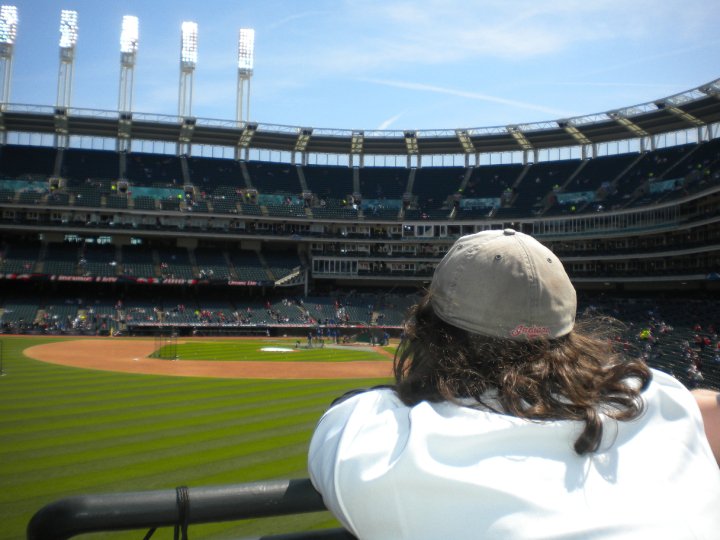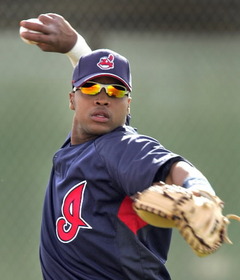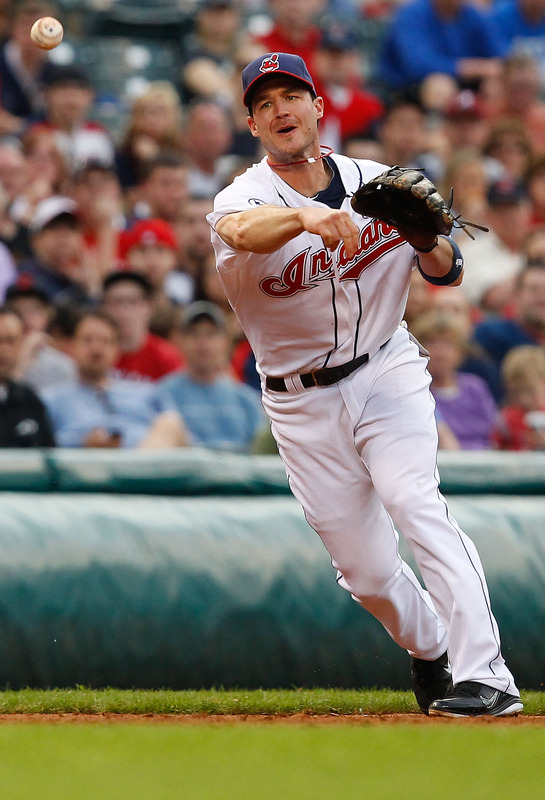 Indians Archive
Indians Archive  View from the Porch: A Coat of Spring Training Primer
View from the Porch: A Coat of Spring Training Primer
 Last Sunday, I was coming out of a 3 p.m. Lake Erie Monsters game hockey on my way to the Baron Cup I championship game for high school hockey. I glanced over to my right and noticed the bright red banner with the Indians “Countdown to Opening Day” showed just a “5” with no second number following it. I stopped and peered through the gates, seeing an empty stadium with a field still covered in a couple inches of snow and then an epiphany hit me...
Last Sunday, I was coming out of a 3 p.m. Lake Erie Monsters game hockey on my way to the Baron Cup I championship game for high school hockey. I glanced over to my right and noticed the bright red banner with the Indians “Countdown to Opening Day” showed just a “5” with no second number following it. I stopped and peered through the gates, seeing an empty stadium with a field still covered in a couple inches of snow and then an epiphany hit me...
It was 5:30 in the afternoon/evening and it was still light out. Days, weeks, and months tend to run together. Half the time, I’m lucky if I wake up and know what day of the week it is. But, when it’s 5:30 in Cleveland, I’m still cold walking around downtown, and it’s still light out, I know that Spring Training is right around the corner. Events and important dates always seem so far away and then, all of the sudden, it’s the day before whatever you were waiting for. When the 2011 season ended, the 2012 season felt like light years away. Now, it’s less than 50 days away. Spring Training starts on Monday.
Spring Training is always such an interesting time of year. The novelty of having baseball to talk about again. Turning on the Indians Radio Network to hear the soothing voice of Tom Hamilton during those first couple Spring Training games. The laundry list of optimistic thoughts that begin “If (player) does this...” or “If we stay healthy...”.
Of course, by about the middle of March, players and fans are ready for Spring Training to be over because it’s a couple weeks too long. Hitters all over the place have inflated numbers due to the prime hitting conditions and pitchers throwing one pitch for their entire outing to get a feel for it. It’s hard to put a lot into Spring Training statistics and get excited about them because they don’t mean anything.
That being said, there are a handful of things I’m looking forward to seeing this Spring and they’ll be the subject of this week’s View from the Porch.
 1. Coming to camp in shape – We’re all hearing the reports of Miguel Cabrera working hard to lose weight so that he can show up to camp in shape (I’m assuming by shape, he means a sphere). Showing up to camp in prime physical condition shows personal commitment. I want the majority of my guys to show up like they care, not to show up like they’ve been eating Cheetos and playing Call of Duty Modern Warfare 3 for the better part of four months.
1. Coming to camp in shape – We’re all hearing the reports of Miguel Cabrera working hard to lose weight so that he can show up to camp in shape (I’m assuming by shape, he means a sphere). Showing up to camp in prime physical condition shows personal commitment. I want the majority of my guys to show up like they care, not to show up like they’ve been eating Cheetos and playing Call of Duty Modern Warfare 3 for the better part of four months.
This is especially true of players who are fighting for a position. I fully expect Lonnie Chisenhall, Jack Hannahan, Dan Wheeler, Jeanmar Gomez, David Huff, Jon Garland, Shelley Duncan, and all of the non-roster invites and minor league deal guys to show up in excellent shape. First impressions are a big deal in the Spring. If you’re already behind the curve on day one, not only is that a bad sign, but it also means you have to work that much harder to get in the competition. The more time you have to spend doing side work calisthenics, lifting, or other forms of cardio could be swept working on hitting timing or pitching mechanics.
As a team that absolutely must have guys capable of going first-to-third, first-to-home, and second-to-home because of a lack of power hitters, they all need to come to camp prepared for that.
Players like Asdrubal Cabrera, who has had weight issues in the past, Carlos Santana, who had weight issues last year, Shin-Soo Choo, Michael Brantley, and others also need to set a good example for the young guys in camp and show them that success is not just some right or privilege. It’s something that has to be constantly worked at and that includes taking care of your body.
Furthermore, coming to camp in shape should cut down on the muscle injuries that plague most teams early in the Spring. Too many teams wind up with injuries to obliques, groins, or hamstrings. These stunt development and also keep players from getting their timing down or working on other drills. There’s no excuse for coming to camp out of shape and suffering one of these injuries. Just because the professional baseball season lasts from April-October doesn’t mean that the other six months are for being lazy.
 2. The third base showdown – This is really the only major position battle of note. I will touch on another further down the column, but I think that my assumption on the winner is pretty safe. Third base, on the other hand, is pretty wide open. Both Jack Hannahan and Lonnie Chisenhall showed flashes of brilliance at the plate in 2011 and Hannahan is certainly a better fielder than Chisenhall. Chisenhall, however, is the future and also has the higher ceiling in terms of offensive contribution.
2. The third base showdown – This is really the only major position battle of note. I will touch on another further down the column, but I think that my assumption on the winner is pretty safe. Third base, on the other hand, is pretty wide open. Both Jack Hannahan and Lonnie Chisenhall showed flashes of brilliance at the plate in 2011 and Hannahan is certainly a better fielder than Chisenhall. Chisenhall, however, is the future and also has the higher ceiling in terms of offensive contribution.
All things considered, both players’ 2011 slash lines look similar. Chisenhall posted a .255/.284/.415/.699 in 212 at bats while Hannahan’s final totals were .250/.331/.388/.719 in 320 AB. Clearly, neither of these lines are worthy of being an everyday third baseman. These are the two players fighting for the job however...or are they? What about Jason Donald? Jason Donald, who is seemingly being groomed to be a super utility guy by taking some fly balls during the Arizona Fall League, put up a .318/.364/.402/.765 in just 132 AB in a season mired by injuries. If we include Donald’s 296 AB in 2010, his career slash is .273/.328/.386/.713. Donald has also played just four games at 3B in the Majors.
I don’t think Donald will be in consideration to be an everyday player because he holds significantly more value as a bench player capable of playing LF/RF/2B/SS/3B. He’s interesting to throw in this discussion, though, because he is a right handed hitter on a team filled with left handed bats. Keep in mind that Donald was the leading candidate to be the starting 3B last season before being hit by a pitch late in Spring Training and breaking his hand, so he could get some reps there.
In any event, the primary battle is likely between Hannahan and Chisenhall. The Indians have expressed concerns with Chisenhall’s plate discipline and strike zone knowledge. I recall many times where Jack Hannahan put up a professional at bat last season, even if he didn’t get a hit. Chisenhall saw 3.74 pitches per PA. Hannahan saw 3.96. Hannahan also swung at 16.2% fewer pitches outside the strike zone than Chisenhall.
On one hand, we can chalk this up to Chisenhall getting his first taste of big league pitching and trying to impress the manager and team brass. On another hand, despite better walk totals in the minors, the Indians are still openly discussing Chisenhall’s plate coverage and discipline as areas of concern. That can’t be a good sign.
What Manny Acta and the rest of the coaching staff have to do is determine if Chisenhall’s offensive potential outweighs the defense that they know Jack Hannahan will provide. If Chisenhall gives you very similar numbers to what Jack Hannahan can give you, is Chisenhall gaining experience more important to the team than Hannahan’s Gold Glove caliber defense with a ground ball pitching staff? If Chisenhall hits 20 points higher for average, drives in 30-35 more runs, and hits five or six more home runs, is that worth the defensive downgrade? Are there thresholds for average, OBP, HR, RBI that Chisenhall would have to meet in order to send Hannahan to the bench as a defensive replacement?
It’s a big decision and one that is a major key to the Indians season. There are pros and cons coming from every angle. If Lonnie Chisenhall hits in Spring Training and shows that he has made some strides with his plate discipline, it makes the decision very difficult. If he doesn’t, I don’t think there’s a decision to be made. Quite frankly, and I’m not sure too many people feel this way, I think it’s Jack Hannahan’s job to lose and Lonnie Chisenhall’s job to win. I think the Indians are content with starting the season with Hannahan at the hot corner and getting the guaranteed defense and occasional offensive contribution.
Considering that the rest of the position players are mostly locked into their 25-man roster spots, this is a big deal. The bench will likely be filled with Shelley Duncan, Lou Marson, Jason Donald and then one of the right handed bats, Aaron Cunningham, Russ Canzler, or Ryan Spilborghs, that were acquired this offseason. Jack Hannahan could also make the roster if he loses out to Chisenhall for the starting 3B spot. Because Cunningham is out of minor league options, he may have a slight advantage, although Spilborghs has well over 1500 Major League at bats with a .272/.345/.423/.768 slash line.
 3. The perennial fifth starter battle – It’s been a while since the Indians have had all five men locked in to the rotation entering Spring Training. That’s not an indictment of the organization as probably 25 of the other 30 MLB teams have the same recurring question year after year. Fifth starter spots tend to be revolving doors throughout the season anyway. The Indians’ spot may not be.
3. The perennial fifth starter battle – It’s been a while since the Indians have had all five men locked in to the rotation entering Spring Training. That’s not an indictment of the organization as probably 25 of the other 30 MLB teams have the same recurring question year after year. Fifth starter spots tend to be revolving doors throughout the season anyway. The Indians’ spot may not be.
The Indians have signed veteran right hander Jon Garland to a minor league deal. Garland is damaged goods, coming off torn labrum surgery in July, which is definitely a concern for a 32-year-old with over 2000 Major League innings under his belt. If you’ll recall, Garland was a member of the White Sox up until 2007, posting a 92-81 record with a 4.41 ERA. Think of Jon Garland as Jake Westbrook. In Westbrook’s Indians tenure, he was a consistent innings eater going 69-69 with a 4.29 ERA. Garland’s career WHIP (walks + hits per inning pitched) is 1.38. Westbrook’s is 1.37. In 12 seasons, Garland has induced an average of 24 double plays per year. In 11 seasons, Westbrook has induced an average of 27. Garland averages 207 innings pitched per season, Westbrook averages 201.
While names like David Huff, Kevin Slowey, and Zach McAllister are in this discussion, a healthy Jon Garland should be in the Indians rotation. Outside of his big league experience and ideal fit for the rest of the Tribe’s ground ball rotation, Huff, Slowey, and McAllister are victims of a numbers game because they all have minor league options remaining. Jon Garland probably has an opt-out clause in his contract if he does not make the Indians Opening Day roster, so they would lose him.
While Westbrook was with the Indians, he was a de facto number three or four starter. Garland would be the Indians fifth starter. With rather similar production two spots lower down the rotation, Garland could potentially be one of the top fifth starters in the American League.
Starting the season with Garland allows the Indians to send their starting pitching depth to Columbus where it can continue to grow and develop, gain confidence, and be ready to contribute if a starter goes down. The Indians are in a very advantageous position this season with depth in general, but especially starting pitching depth.
I’ll be looking to see if Jon Garland is healthy this Spring. If he is, that’s a major benefit to the Indians rotation. He’s a proven Major Leaguer who would be on an incentive-laden contract who can also eat innings. When’s the last time a MLB team had a fifth starter capable of eating 180+ innings? I’m not sure I can think of any. That’s an asset to the bullpen.
Overall, it’ll be about six-and-a-half weeks of “what if” questions until the season gets started. Unfortunately, the Indians already used the “What If?” mantra last season for their promotional campaigns. We still have until March 3 until the Indians first game against their Spring Training complex counterpart Cincinnati Reds, but it’s just nice to know that spring is around the corner, the days are getting longer, and the long wait is nearly over.
- NBA Announces 2013-2014 Schedule
- Browns Ink Sharknado
- Sharknado A No-Show For Rookie Camp
- Trent Richardson Out Until Training Camp
- Browns Sign Brandon Jackson
- Carrasco Suspended Eight Games
- Browns Add to Wide Receiver Depth with David Nelson
- Browns Need to Learn from Past Draft Mistakes
- Browns Release Chris Gocong and Usama Young
- Browns Missing on Grimes Disappointing, But Not The End
The TCF Forums
- Chris Grant's first 3 drafts
Kingpin74 (Tuesday, January 21 2014 10:13 AM) - The 2014 Offseason Thread
googleeph2 (Tuesday, January 21 2014 9:36 AM) - 2015 Recruiting
furls (Tuesday, January 21 2014 6:57 AM) - Mike Brown
YahooFanChicago (Monday, January 20 2014 11:15 PM) - Movies coming out
HoodooMan (Monday, January 20 2014 9:34 PM) - 2014 Hoops Hockey Hijinx
jpd1224 (Monday, January 20 2014 4:44 PM) - 2014 Recruiting
jclvd_23 (Monday, January 20 2014 2:26 PM) - Wish List - #4 Pick
Hikohadon (Monday, January 20 2014 1:26 PM) - Official- Browns Coach Search/Rumors
OldDawg (Sunday, January 19 2014 6:48 PM) - #1 overall pick Anthony Bennett
TouchEmAllTime (Sunday, January 19 2014 1:28 PM)



